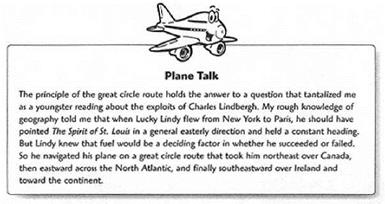What’s So Great About Great Circles?
If the earth’s surface were flat, the shortest distance between two points would be a straight line. But when we’re traveling on the curved surface of a globe, the shortest distance between two points turns out to be something else: an “equator.”
Recall that the geographical equator is a line around the earth that splits the globe into two exactly equal halves. If we ignore the location of the poles and forget that the geographical equator is a line whose points are all at equal distances from both poles, we can imagine a multitude of possible equators circling the globe. In fact, we can imagine connecting any two locations by an equator—that is, the equator will run through both locations with exactly half the globe on either side.
Imagine an equator connecting two points— connecting Rome, New York, to Rome, Italy, for example. Another word for this line is a “great circle,” and a great circle is the shortest distance between the two points—even if that means flying from Rome, New Y ork, to the northeast and arriving in Rome, Italy, from the northwest.
|
|
From a pilot’s point of view, navigating across a great circle route is more difficult than flying a straight-line route. Great circles force pilots to constantly change course, while straight-line courses give us the luxury of pointing the airplane in one direction and holding it there.
But airliners and other planes gulping large amounts of fuel for hours at a time can save a lot of gas and money by trimming minutes off their flight times. So, with the help of computers and complex navigation equipment, they manage to fly a gradual great circle route.
|
On Course Why not build roads and highways in orientation with the magnetic poles? Because the poles have a habit of wandering around Northern Canada in the north and Antarctica in the south. Geologists attribute the movement of the magnetic poles to changes in the movement of the molten rock far below the earth’s surface, where moving currents help generate the earth’s magnetic field. All in all, the magnetic poles arc not reliably attractive. |















